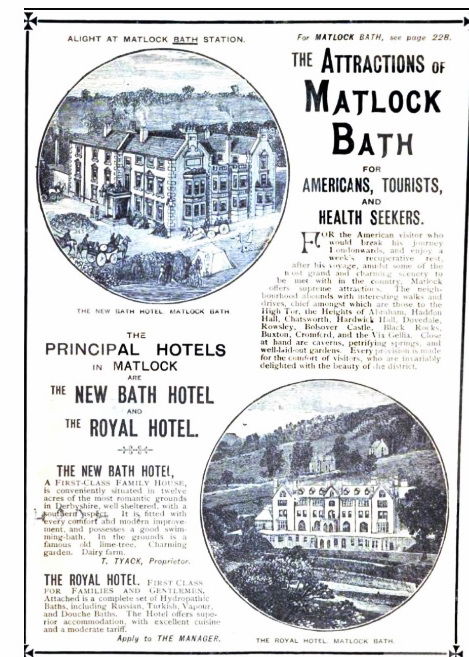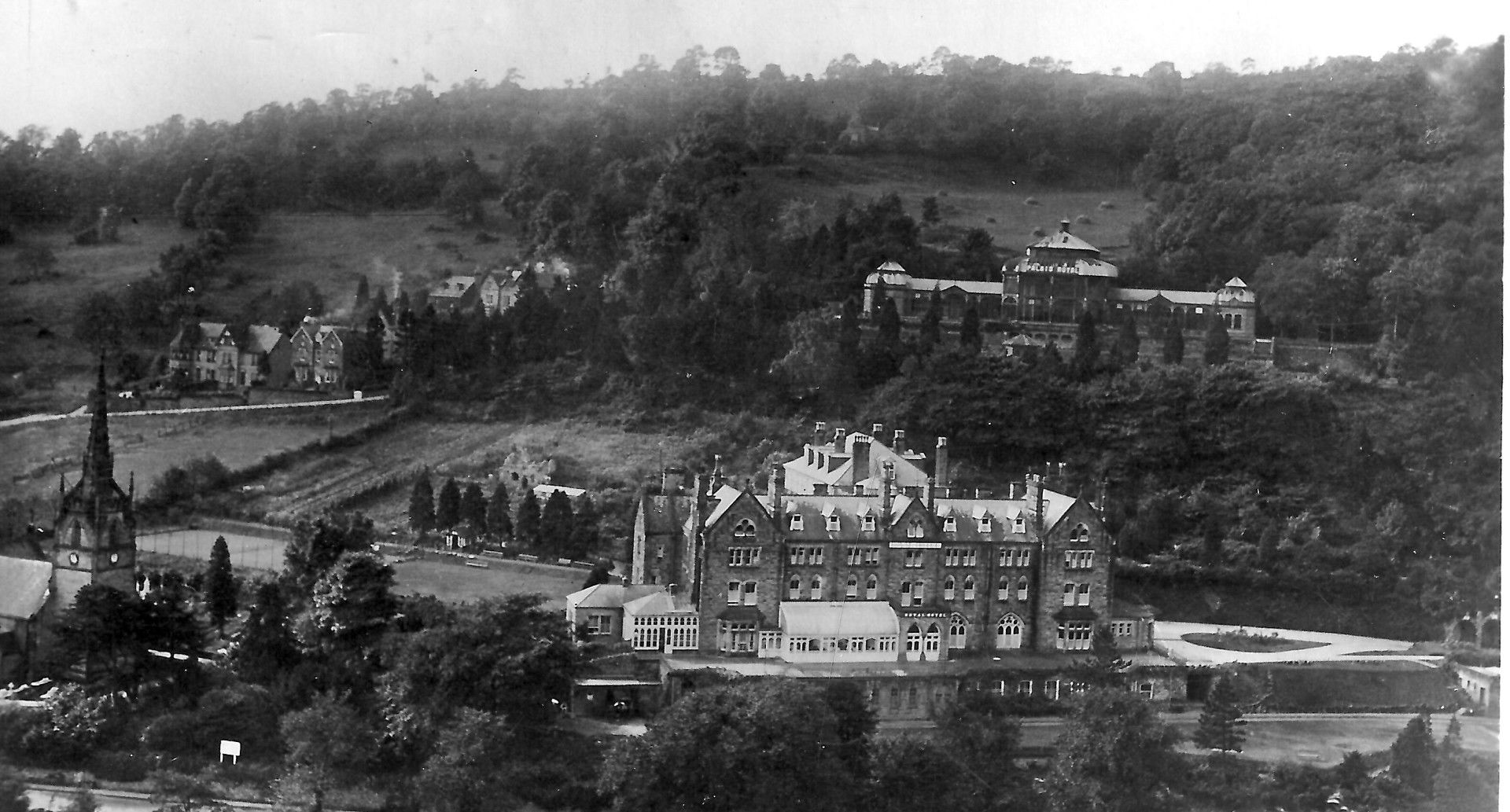Canadians in Matlock Bath in World War One
Buxton’s Canadian Hospitals were not the only Canadian medical facilities in Derbyshire. Whilst writing Maple Leaves in Buxton, I also made brief references to the Canadian Officers Convalescent Hospital at Matlock Bath.
Matlock Bath is south of Matlock on the main A6 road, and approximately halfway between Buxton and Derby. The village developed in the 19th century as residential and a spa town which remains a tourist destination. The steep hillside restricted development, with most buildings on one side of the valley and only footbridges across the river. In 1698, warm springs were discovered, and a bath house was built. As the waters became better known, access was improved by building the bridge into Old Matlock and in 1783, the opening of a new entrance at the south of the valley. John Ruskin and Lord Byron were visitors, Byron comparing it with alpine Switzerland, leading to a nickname of Little Switzerland Matlock Bath railway station was built in 1849 on the Midland Railway line between London and Manchester passing through Buxton.

The Canadian Officers Convalescent Hospital originally opened at Grand °Hotel in Broadstairs, Kent. Like Ramsgate, the nearby Kent town, which had used the Granville Special Hospital, Broadstairs was also at risk from German aerial bombardment. In particular a series of air raids hit the are in August 1917, a particularly heavy raid is described i the War Diary for 22 August 1917.After that the hospital stopped admitting further casualties and all cases were evacuated on 28 August , either to Eato Hall in Cheshire or to London. like the Granville Special Hospital , it moved north to Derbyshire. Since Buxton was running out of space, the hospital relocated to the Royal Hotel at Matlock Bath .

The Royal Hotel was well described in contemporary guidebooks “The “Royal” is a magnificent Gothic pile , covering the ground where once stood the historic “Old Bath” hotel, erected at the commencement of the present century, and the first that provides superior accommodation for visitors. Its swimming bath is still supplied with water from the old Spring, while the public dining and drawing rooms, handsome corridors, conservatory, and numerous bed-rooms, are remarkable for their specious and refined accommodation . The extensive grounds cover some five acres , …
“Military Hospital at Matlock Bath The Canadian Convalescent Officer’s Hospital lately at Broadstairs is now open for the reception of patients for their final cure at the Royal Hoel , Matlock Bath, taken ovrr in December alast and since then subjected to the adaptation necessary to fit it for its new purpose, a purpose which even the oldest habitues of the hotel , accustomed for so many years
From May 1917 the hospital had been under the command of Colonel Percy Gladstone Goldsmith , who accompanied it north to Matlock Bath. On 26 June 1918, he was posted to the CAMC depot and replaced as officer in command of the CCO Hospital by Major Allen Coat Rankin from Montreal. Although lack on much detailed news, the Canadian Hospital News, which covered the Buxton hospitals , usually contained a humorous summary of “ Musings from Matlock” Life seems to have pretty quiet in Matlock, with the War Diary reporting nothing more exciting than the highly variable weather and a series of inspection visits.
In June 1918, Canadian Prime Minister Sir Robert Borden visited on his way back from visiting Canadian hospitals in Buxton. He made a stirring address to Canadian officers . Borden's diary recorded the trip:
"Saturday, June 22, 1918 Rose very early, attended to correspondence and at 10.15 proceeded to Kemp's office which we left at 10.45 for Matlock and Buxton via St. Albans, Dunstable, Northampton (luncheon) Leicester, Loughborough and Derby. Arrived Matlock Bath 4.20, inspected hospital (officers convalescent) addressed officers (among them McKeen) and congratulated Col. Goldsmith a very capable and devoted officer. Then to Buxrton, went over Can. Discharge Depot (Col. Hanson a fine capable earnest officer) dined with him and then to Can. Nurses Hosp. where we saw many sisters who were bombed at Doullens and Etaples. They had no doubt as to the purpose and intent of the Germans, machine guns were used upon the huts where the sisters and patients were. Invited to stay at Bowens (Mrs. Bowen nee Osler). Arrived there about 10. Col. Hanson and Col. Hartt accompanied us. Henry was with us on the trip and he met at Matlock Ernst of Lunenburg who was at Kings and who knew Henry."
Addressing the officers, Sir Robert stressed that Canada was in the war until the end , compulsory military service had been accepted from end to end of the Dominion and whatever reinforcements needed would be provided. A German offensive was expected in the very near future , and if they attacked the Canadian line, however stern or severe the test, the Canadians would rise to the occasion. He bought to the mean , the intense appreciation of Canada for all the services rendered and the sacrifices made. He wished the officers God-speed in all they had before then and Good-speed in the cause for which they had fought so well.
His diary then records the following Sunday in Buxton and Matlock-
"Sunday , June 23, 1918 At 9.30 went to Red Cross Hosp (Col. Burnett) and then to Grenville Can.Special Hosp (Buxton Hydropath) and Palace Hotel. Addressed patients at both places. Col. Clark in command. Organization of Grenville Hosp. most efficient. Clark very capable man. Then to luncheon and started for Haddon Hall, very interesting visit, and then to Chatsworth where we spent an hour. A most wonderful place of great beauty and of historic interest and full of art treasures. Then to Matlock Bath Hosp. for tea and started for London at 6.50. Three punctures en route and reached London at 10.53, 4 h. 20 Min. actual running time. A most glorious summer day but cool. Crowds of people in the open air everywhere. Very dusty. Went over Sunday papers. One of them says speeches at Friday's function poor. I agree. News from Italy fairly good."
July 1918, saw a sudden outbreak of influenza recorded in the War Diary of the CCO , with five other ranks suddenly being hit – suffering from headache and pyrexia. The pandemic is usually regarded having begun on 4 March 1918 with the recording of the case of “patient zero” Albert Gitchell, an army cook at Camp Funston in Kansas, United States. Within days 522 men at the camp had reported sick. Failure to take preventive measures in March/April allowed the disease to spread . Camp Funston, was a major training ground for troops of the American Expeditionary Forces, and from there spread to U.S. Army camps and Europe, reaching the Western Front by mid-April. It then quickly spread to the rest of France, Great Britain, Italy, and Spain . Owing to wartime reporting restrictions, it was only in neutral Spain that the pandemic was freely reported, gaining the name Spanish flu . The first wave was relatively mild with mortality rates not appreciably above normal; in the United States ~75,000 flu-related deaths were reported in the first six months of 1918, compared to ~63,000 deaths during the same time period in 1915. In Madrid, Spain, fewer than 1,000 people died from influenza between May and June 1918.. This first wave caused significant disruption in the military operations with three-quarters of French troops, half the British forces, and over 900,000 German soldiers’ sick .
In October 1918, there was a further influenza outbreak among the nurses and patients in Matlock Bath. The second wave of the 1918 pandemic was much more deadly than the first. The first wave had resembled typical flu epidemics; those most at risk were the sick and elderly, while younger, healthier people recovered easily. October 1918 was the month with the highest mortality-rate of the whole pandemic. In the United States, ~292,000 deaths were reported between September–December 1918, compared to ~26,000 during the same period in 1915. It was not until later in the winter and into the spring that a clearer resurgence appeared in Europe. A significant third wave had developed in England and Wales by mid-February, peaking in early March, though it did not fully subside until May The CCOH in Matlock Bath seems to have escaped the worst of the influenza outbreak, since there are no Canadian War Graves in Matlock from that time One might speculate that the smaller population of soldiers in Matlock, ( say 200 rather than 2000) and the fact that tey were convalescent officers, as compared to many of the patients in Buxton who were 3far more seriously ill and possibly more immune suppressed .
On 11 November, the War diary records that at 10.45 , a phone message was received . "Armistice signed. " which was the cause for great rejoicing. After the armistice, the hospital continued use, until finally closing, albeit with a reducing number of staff
Colonel Goldsmith's records
https://recherche-collection-search.bac-lac.gc.ca/eng/Home/Record?app=pffww&IdNumber=417365&eco
Colonel Rankin’s records
https://recherche-collection-search.bac-lac.gc.ca/eng/Home/Record?app=pffww&IdNumber=587686&ecop